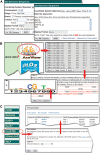SysZNF: the C2H2 zinc finger gene database
- PMID: 18974185
- PMCID: PMC2686507
- DOI: 10.1093/nar/gkn782
SysZNF: the C2H2 zinc finger gene database
Abstract
C2H2 zinc finger (C2H2-ZNF) genes are one of the largest and most complex gene super-families in metazoan genomes, with hundreds of members in the human and mouse genome. The ongoing investigation of this huge gene family requires computational support to catalog genotype phenotype comparisons of C2H2-ZNF genes between related species and finally to extend the worldwide knowledge on the evolution of C2H2-ZNF genes in general. Here, we systematically collected all the C2H2-ZNF genes in the human and mouse genome and constructed a database named SysZNF to deposit available datasets related to these genes. In the database, each C2H2-ZNF gene entry consists of physical location, gene model (including different transcript forms), Affymetrix gene expression probes, protein domain structures, homologs (and synteny between human and mouse), PubMed references as well as links to relevant public databases. The clustered organization of the C2H2-ZNF genes is highlighted. The database can be searched using text strings or sequence information. The data are also available for batch download from the web site. Moreover, the graphical gene model/protein view system, sequence retrieval system and some other tools embedded in SysZNF facilitate the research on the C2H2 type ZNF genes under an integrative view. The database can be accessed from the URL http://epgd.biosino.org/SysZNF.
Figures



References
-
- Klug A, Schwabe JW. Protein motifs 5. Zinc fingers. FASEB J. 1995;9:597–604. - PubMed
-
- Sander TL, Stringer KF, Maki JL, Szauter P, Stone JR, Collins T. The SCAN domain defines a large family of zinc finger transcription factors. Gene. 2003;310:29–38. - PubMed
-
- Huynh KD, Bardwell VJ. The BCL-6 POZ domain and other POZ domains interact with the co-repressors N-CoR and SMRT. Oncogene. 1998;17:2473–2484. - PubMed
Publication types
MeSH terms
Substances
LinkOut - more resources
Full Text Sources
Other Literature Sources

